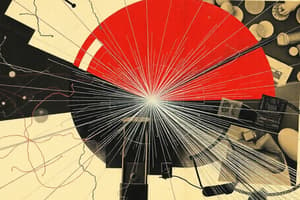Podcast
Questions and Answers
What is a key difference between magnetic forces and electrostatic forces?
What is a key difference between magnetic forces and electrostatic forces?
- Magnetic forces extend over vast distances (correct)
- Magnetic forces decrease with distance
- Electrostatic forces attract each other
- Electrostatic forces can be influenced by motion
In what scenario do two identical magnets stick together?
In what scenario do two identical magnets stick together?
- When they are separated by distance
- When they have the same pole
- When they are brought close together (correct)
- When they have opposite poles
What phenomenon describes the generation of an electromagnetic field in a coil of wire when a magnet is introduced near it?
What phenomenon describes the generation of an electromagnetic field in a coil of wire when a magnet is introduced near it?
- Electromagnetic propagation
- Magnetic repulsion
- Electromagnetic induction (correct)
- Magnetic alignment
Which application is NOT mentioned as using electromagnetic waves?
Which application is NOT mentioned as using electromagnetic waves?
What type of waves are composed of a combination of electric and magnetic fields that oscillate in space and time?
What type of waves are composed of a combination of electric and magnetic fields that oscillate in space and time?
Which technology is NOT based on electromagnetic induction principles?
Which technology is NOT based on electromagnetic induction principles?
What is the branch of physics that deals with interactions between electrically charged particles?
What is the branch of physics that deals with interactions between electrically charged particles?
In electromagnetism, what happens when two positively charged objects are brought close to each other?
In electromagnetism, what happens when two positively charged objects are brought close to each other?
What type of forces arise when electric charges move, creating a magnetic field?
What type of forces arise when electric charges move, creating a magnetic field?
What happens when a positive charge and a negative charge are brought close together?
What happens when a positive charge and a negative charge are brought close together?
What causes lightning to occur as described in the text?
What causes lightning to occur as described in the text?
What property of magnets causes them to exert forces on other magnets or moving charges?
What property of magnets causes them to exert forces on other magnets or moving charges?
Study Notes
Exploring Electromagnetism in Physics
Electromagnetism is a branch of physics that deals with the interactions between electrically charged particles. It involves analyzing how these interactions occur and the resulting effects on physical systems. This subfield of physics has led to significant advancements in understanding the behavior of light, electricity, and magnetism. Let's delve into the fascinating world of electromagnetism.
Understanding Electric Charge
One of the fundamental concepts in electromagnetism is electric charge, which can be positive or negative. When two oppositely charged objects come close enough, they exert forces on each other known as electrostatic forces. These forces follow an inverse square law, meaning the force decreases rapidly as the distance between the charges increases.
Positive charges repel one another and attract negative charges, while negative charges behave the opposite way. This behavior leads to interesting phenomena, such as lightning, which occurs when positively charged air in clouds becomes attracted to the negatively charged ground.
Magnetic Forces
Magnetic forces arise when electric charges move, creating a magnetic field. Magnets themselves possess an intrinsic property called magnetization, which causes them to exert attractive or repulsive forces on other magnets or moving charges. Unlike electrostatic forces, which decrease with distance, magnetic forces extend over vast distances and can be influenced by the presence of motion or current flow.
Magnets can align in several ways depending on the strength of the magnetic fields. Two magnets with opposite poles attract each other, while those with the same pole repel. When two identical magnets are brought close together, they may stick together, illustrating the strong binding effect of magnetic forces.
Electromagnetic Induction
A remarkable phenomenon in electromagnetism is electromagnetic induction, which describes the generation of an electromagnetic field in a coil of wire when a magnet is introduced near it. This process can be reversed, meaning that a changing magnetic field can also induce a current in a wire. This principle is the basis for the operation of generators, transformers, and motors.
Electromagnetic Waves
Electromagnetic waves are a unique combination of electric and magnetic fields that oscillate in space and time. These waves propagate at the speed of light and can carry energy. They are further divided into radio waves, microwaves, infrared radiation, visible light, ultraviolet radiation, X-rays, and gamma rays, depending on their wavelength and energy.
Electromagnetic waves are used in various applications, such as radio communication, satellite transmission, and medical imaging techniques like X-rays and CT scans. Light itself is composed of electromagnetic waves, which enables us to see the colorful wonders of the natural world.
In conclusion, electromagnetism plays a crucial role in shaping our understanding of the fundamental forces governing our universe. By exploring these interactions further, scientists have developed technologies like generators, transformers, radio communication, satellite transmission, and even medical imaging techniques. As we continue to unlock the mysteries of electromagnetism, its impact on society will undoubtedly grow.
Studying That Suits You
Use AI to generate personalized quizzes and flashcards to suit your learning preferences.
Description
Test your knowledge on electromagnetism, a fascinating branch of physics that studies the interactions between electrically charged particles, magnetic forces, electromagnetic induction, and electromagnetic waves. Dive into the fundamental concepts and applications of electromagnetism with this quiz.




